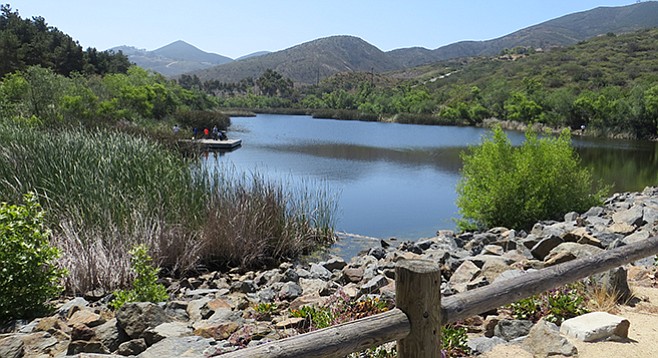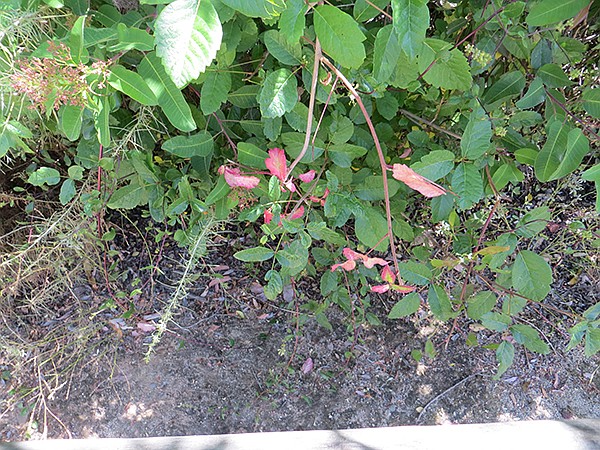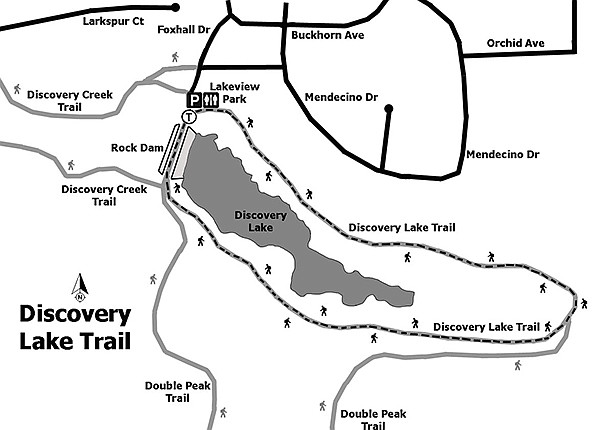 Facebook
Facebook
 X
X
 Instagram
Instagram
 TikTok
TikTok
 Youtube
Youtube

The loop around Discovery Lake in San Marcos makes a perfect hike for those who want to do a light and easy stroll but still see a diversity of species and beautiful lake scenery. This multi-use paved, short trail is open to hikers of all skills, joggers, bicyclists, strollers, wheelchairs, pets, and families. Once around the lake, there are various trails to extend your hike. The other available hikes in the area vary in length, elevation, and difficulty, depending on fitness level.
This five-acre lake is located in a quiet residential area next to a playground with restroom access. The trail is maintained and kept clean, and benches can be found dispersed on opposite sides of the lake for those who may want to sit and enjoy the surrounding serenity. No swimming or wading in the lake, but catch-and-release fishing is allowed.
If you choose to go on a hot, sunny day, there is plenty of shade with sycamores, coast live oaks, arroyo willows, toyons, and laurel sumacs surrounding the lake as well as other lower growing vegetation. However, be cautious of getting too close to the vegetation, as there are visible signs warning people of poison oak. Tread carefully, as there is a chance of encountering snakes during the spring, summer, and fall seasons.

The lake offers a dock where hikers can get closer to ruddy ducks, mallards, and American coots, which can be found around the lake on any given day. You are also likely to see such bird species as the white-crowned sparrow, Nuttall’s woodpecker, spotted towhee, California thrasher, western scrub jay, bushtit, Anna’s hummingbird, red-winged blackbird, California quail, and mourning dove, as there are usually seeds placed for the birds atop the wooden fence corralling the lake. You may be lucky enough to spot a red-shouldered hawk, as they like to reside in this riparian habitat — they especially like to live in sycamore and oak woodlands. Butterflies, amphibians, and mammals also find the riparian area an attractive place to obtain water, food, and shelter. You don’t have to go far to feel like you are immersed in nature on this hike, as you are transported there.
Double-crested cormorants are often seen in exposed locations with their wings spread open to dry. Their feathers retain water because they have less preen oil than other birds and are heavier, which may be an advantage when hunting underwater for their diet of fish. Both adult males and females have black, white, or a mixture of nuptial crests during breeding season. Bring binoculars in hopes that you can see the blue color of both their eyes and inside their mouths. These yellow-orange-throated dark birds are the most widespread cormorant in North America and are found both at the coast and inland fresh-water lakes.

This trail can be visited and enjoyed all year long in the generally sunny San Diego weather.
Since the trail is paved and close to the residential areas, residents and visitors can be found exercising on the trail or biking on a daily basis, even on a rainy day.
Distance from downtown San Diego: 36 miles. Allow 40 minutes driving time. (San Marcos). From CA-163 N, merge onto I-15 N, then take exit 32 onto CA-78 W. Take exit 13 (Twin Oaks Valley Road) then turn left at the end of the exit onto South Twin Oaks Valley Road. Turn right onto Discovery Street and continue onto Rush Drive before turning right onto Craven Road. Turn left onto Foxhall Drive. There is a small parking lot at Discovery Lake (650 Foxhall Drive, San Marcos, CA 92078) with more parking available on residential streets.
Hiking length: 0.75 mile round-trip.
Difficulty: Easy, with less than 50 feet elevation loss/gain. Facilities in Lakeview Park.


The loop around Discovery Lake in San Marcos makes a perfect hike for those who want to do a light and easy stroll but still see a diversity of species and beautiful lake scenery. This multi-use paved, short trail is open to hikers of all skills, joggers, bicyclists, strollers, wheelchairs, pets, and families. Once around the lake, there are various trails to extend your hike. The other available hikes in the area vary in length, elevation, and difficulty, depending on fitness level.
This five-acre lake is located in a quiet residential area next to a playground with restroom access. The trail is maintained and kept clean, and benches can be found dispersed on opposite sides of the lake for those who may want to sit and enjoy the surrounding serenity. No swimming or wading in the lake, but catch-and-release fishing is allowed.
If you choose to go on a hot, sunny day, there is plenty of shade with sycamores, coast live oaks, arroyo willows, toyons, and laurel sumacs surrounding the lake as well as other lower growing vegetation. However, be cautious of getting too close to the vegetation, as there are visible signs warning people of poison oak. Tread carefully, as there is a chance of encountering snakes during the spring, summer, and fall seasons.

The lake offers a dock where hikers can get closer to ruddy ducks, mallards, and American coots, which can be found around the lake on any given day. You are also likely to see such bird species as the white-crowned sparrow, Nuttall’s woodpecker, spotted towhee, California thrasher, western scrub jay, bushtit, Anna’s hummingbird, red-winged blackbird, California quail, and mourning dove, as there are usually seeds placed for the birds atop the wooden fence corralling the lake. You may be lucky enough to spot a red-shouldered hawk, as they like to reside in this riparian habitat — they especially like to live in sycamore and oak woodlands. Butterflies, amphibians, and mammals also find the riparian area an attractive place to obtain water, food, and shelter. You don’t have to go far to feel like you are immersed in nature on this hike, as you are transported there.
Double-crested cormorants are often seen in exposed locations with their wings spread open to dry. Their feathers retain water because they have less preen oil than other birds and are heavier, which may be an advantage when hunting underwater for their diet of fish. Both adult males and females have black, white, or a mixture of nuptial crests during breeding season. Bring binoculars in hopes that you can see the blue color of both their eyes and inside their mouths. These yellow-orange-throated dark birds are the most widespread cormorant in North America and are found both at the coast and inland fresh-water lakes.

This trail can be visited and enjoyed all year long in the generally sunny San Diego weather.
Since the trail is paved and close to the residential areas, residents and visitors can be found exercising on the trail or biking on a daily basis, even on a rainy day.
Distance from downtown San Diego: 36 miles. Allow 40 minutes driving time. (San Marcos). From CA-163 N, merge onto I-15 N, then take exit 32 onto CA-78 W. Take exit 13 (Twin Oaks Valley Road) then turn left at the end of the exit onto South Twin Oaks Valley Road. Turn right onto Discovery Street and continue onto Rush Drive before turning right onto Craven Road. Turn left onto Foxhall Drive. There is a small parking lot at Discovery Lake (650 Foxhall Drive, San Marcos, CA 92078) with more parking available on residential streets.
Hiking length: 0.75 mile round-trip.
Difficulty: Easy, with less than 50 feet elevation loss/gain. Facilities in Lakeview Park.
Comments